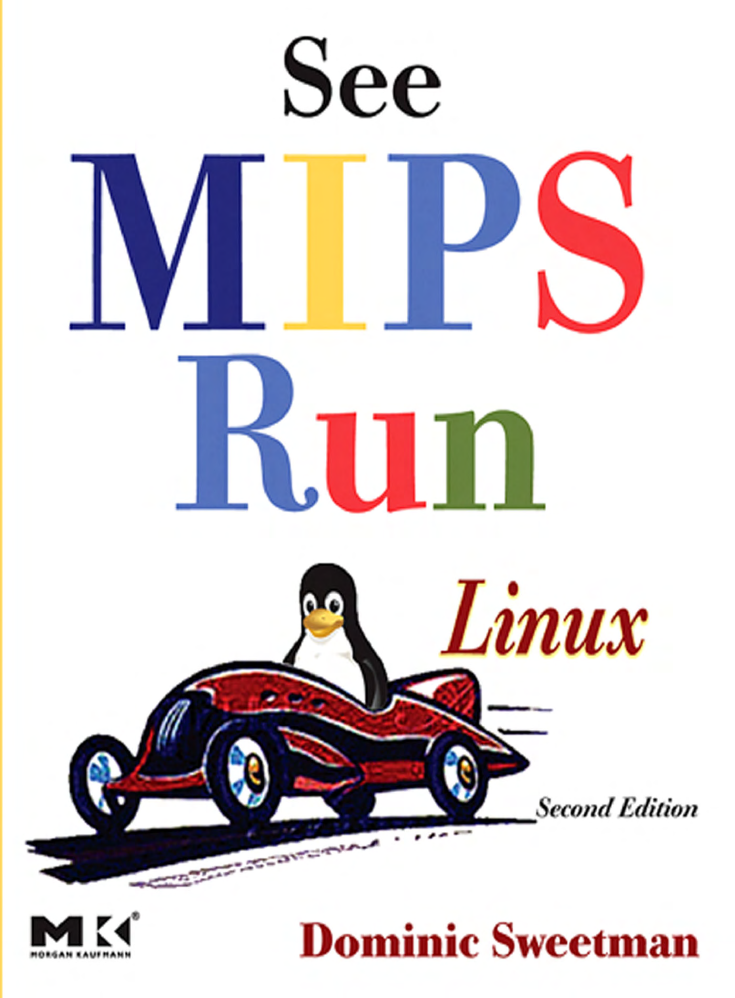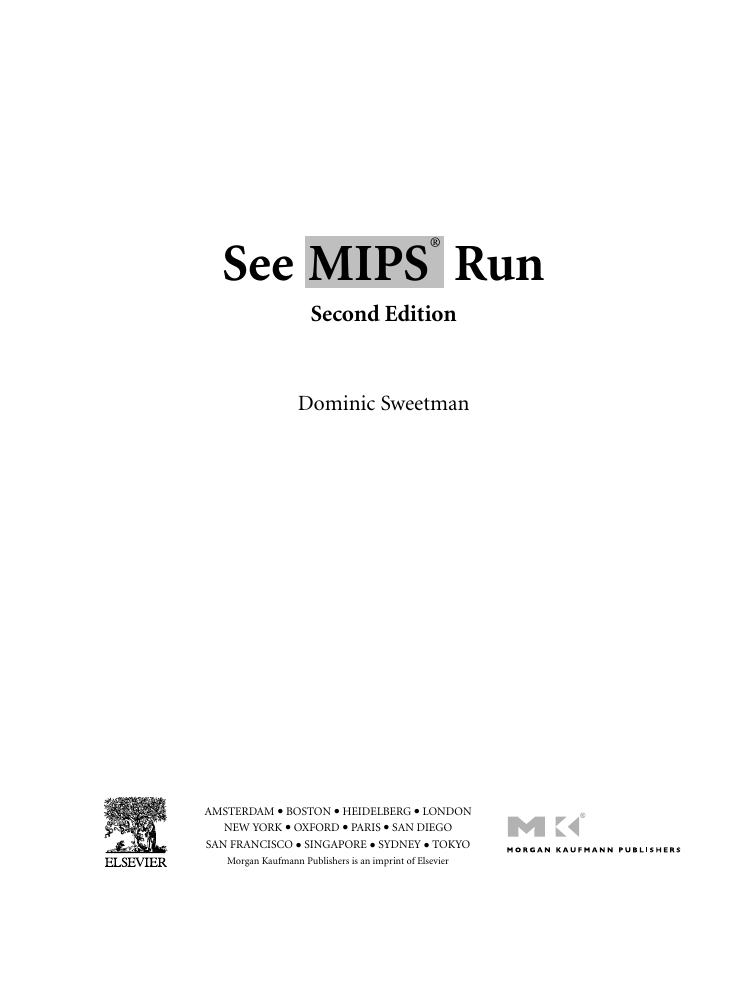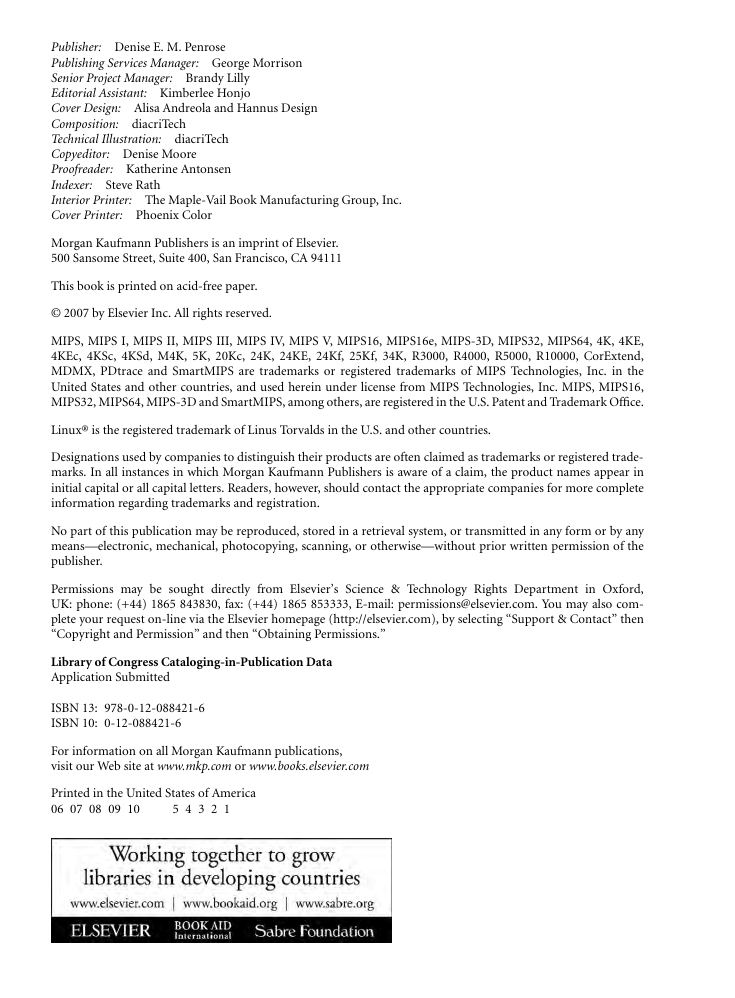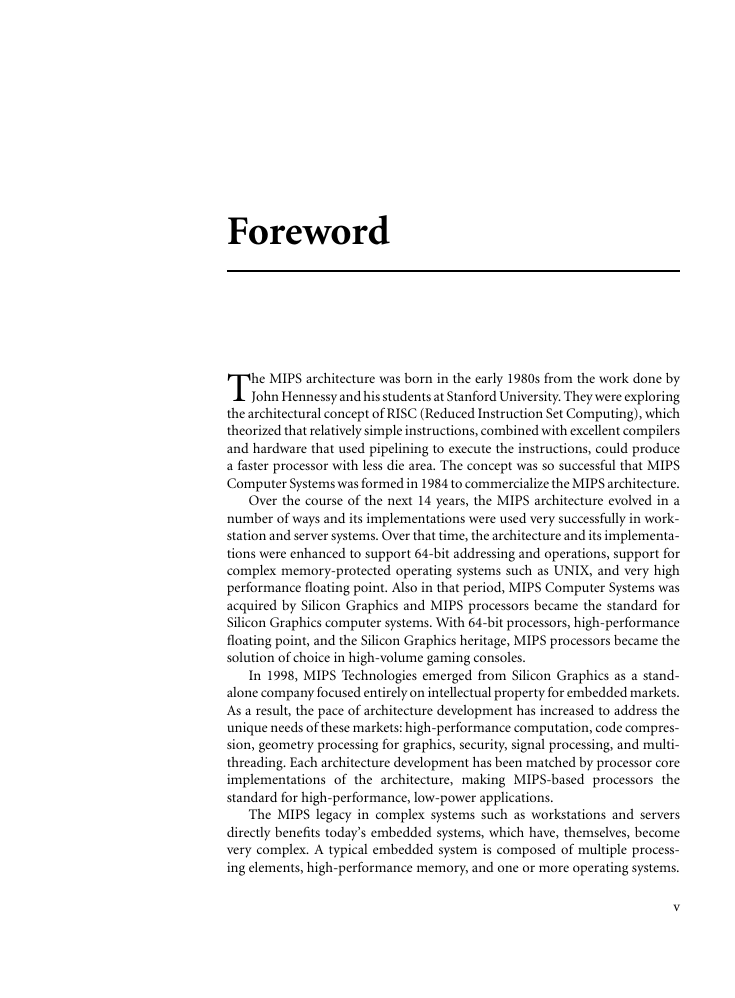�
See MIPS® Run
Second Edition
This Page Intentionally Left Blank
�
See MIPS® Run
Second Edition
Dominic Sweetman
AMSTERDAM • BOSTON • HEIDELBERG • LONDON
SAN FRANCISCO • SINGAPORE • SYDNEY • TOKYO
NEW YORK • OXFORD • PARIS • SAN DIEGO
Morgan Kaufmann Publishers is an imprint of Elsevier
�
Publisher: Denise E. M. Penrose
Publishing Services Manager: George Morrison
Senior Project Manager: Brandy Lilly
Editorial Assistant: Kimberlee Honjo
Cover Design: Alisa Andreola and Hannus Design
Composition: diacriTech
Technical Illustration: diacriTech
Copyeditor: Denise Moore
Proofreader: Katherine Antonsen
Indexer:
Interior Printer: The Maple-Vail Book Manufacturing Group, Inc.
Cover Printer: Phoenix Color
Steve Rath
Morgan Kaufmann Publishers is an imprint of Elsevier.
500 Sansome Street, Suite 400, San Francisco, CA 94111
This book is printed on acid-free paper.
© 2007 by Elsevier Inc. All rights reserved.
MIPS, MIPS I, MIPS II, MIPS III, MIPS IV, MIPS V, MIPS16, MIPS16e, MIPS-3D, MIPS32, MIPS64, 4K, 4KE,
4KEc, 4KSc, 4KSd, M4K, 5K, 20Kc, 24K, 24KE, 24Kf, 25Kf, 34K, R3000, R4000, R5000, R10000, CorExtend,
MDMX, PDtrace and SmartMIPS are trademarks or registered trademarks of MIPS Technologies, Inc. in the
United States and other countries, and used herein under license from MIPS Technologies, Inc. MIPS, MIPS16,
MIPS32, MIPS64, MIPS-3D and SmartMIPS, among others, are registered in the U.S. Patent and Trademark Office.
Linux® is the registered trademark of Linus Torvalds in the U.S. and other countries.
Designations used by companies to distinguish their products are often claimed as trademarks or registered trade-
marks. In all instances in which Morgan Kaufmann Publishers is aware of a claim, the product names appear in
initial capital or all capital letters. Readers, however, should contact the appropriate companies for more complete
information regarding trademarks and registration.
No part of this publication may be reproduced, stored in a retrieval system, or transmitted in any form or by any
means—electronic, mechanical, photocopying, scanning, or otherwise—without prior written permission of the
publisher.
Permissions may be sought directly from Elsevier’s Science & Technology Rights Department in Oxford,
UK: phone: (+44) 1865 843830, fax: (+44) 1865 853333, E-mail: permissions@elsevier.com. You may also com-
plete your request on-line via the Elsevier homepage (http://elsevier.com), by selecting “Support & Contact” then
“Copyright and Permission” and then “Obtaining Permissions.”
Library of Congress Cataloging-in-Publication Data
Application Submitted
ISBN 13: 978-0-12-088421-6
ISBN 10: 0-12-088421-6
For information on all Morgan Kaufmann publications,
visit our Web site at www.mkp.com or www.books.elsevier.com
Printed in the United States of America
06 07 08 09 10
5 4 3 2 1
�
Foreword
The MIPS architecture was born in the early 1980s from the work done by
John Hennessy and his students at Stanford University. They were exploring
the architectural concept of RISC (Reduced Instruction Set Computing), which
theorized that relatively simple instructions, combined with excellent compilers
and hardware that used pipelining to execute the instructions, could produce
a faster processor with less die area. The concept was so successful that MIPS
Computer Systems was formed in 1984 to commercialize the MIPS architecture.
Over the course of the next 14 years, the MIPS architecture evolved in a
number of ways and its implementations were used very successfully in work-
station and server systems. Over that time, the architecture and its implementa-
tions were enhanced to support 64-bit addressing and operations, support for
complex memory-protected operating systems such as UNIX, and very high
performance floating point. Also in that period, MIPS Computer Systems was
acquired by Silicon Graphics and MIPS processors became the standard for
Silicon Graphics computer systems. With 64-bit processors, high-performance
floating point, and the Silicon Graphics heritage, MIPS processors became the
solution of choice in high-volume gaming consoles.
In 1998, MIPS Technologies emerged from Silicon Graphics as a stand-
alone company focused entirely on intellectual property for embedded markets.
As a result, the pace of architecture development has increased to address the
unique needs of these markets: high-performance computation, code compres-
sion, geometry processing for graphics, security, signal processing, and multi-
threading. Each architecture development has been matched by processor core
implementations of the architecture, making MIPS-based processors the
standard for high-performance, low-power applications.
The MIPS legacy in complex systems such as workstations and servers
directly benefits today’s embedded systems, which have, themselves, become
very complex. A typical embedded system is composed of multiple process-
ing elements, high-performance memory, and one or more operating systems.
v
�
vi
Foreword
When compared with other embedded architectures, which are just now
learning what is required to build a complex system, the MIPS architecture
provides a proven base on which to implement such systems.
In many ways, the first edition of See MIPS Run was a ground-breaking book
on the MIPS architecture and its implementations. While other books cov-
ered similar material, See MIPS Run focused on what the programmer needed
to understand of the architecture and the software environment in order to
effectively program a MIPS chip.
Increasing complexity of embedded systems has been matched by enhance-
ments to the MIPS architecture to address the needs of such systems. The
second edition of this book is required reading for any current developer of
MIPS-based embedded systems. It adds significant new material, including the
architectural standardization of
the MIPS32 and MIPS64 architectures,
brand new application-specific extensions such as multithreading, and a very
nice treatment of the implementation of the popular Linux operating system
on the MIPS architecture. Short of the MIPS architecture specifications, the
second edition of See MIPS Run is the most current description of the state of
the art of the architecture and is, bar none, the most readable.
I hope that you will find this as worthwhile and as entertaining to read
as I did.
Michael Uhler,
Chief Technology Officer, MIPS Technologies, Inc.
Mountain View, CA
May 2006
�
Contents
Foreword
Preface
Style and Limits
Conventions
Acknowledgments
Chapter 1 RISCs and MIPS Architectures
1.1
Pipelines
1.1.1 What Makes a Pipeline Inefficient?
1.1.2
The Pipeline and Caching
1.2 The MIPS Five-Stage Pipeline
1.3 RISC and CISC
1.4 Great MIPS Chips of the Past and Present
R2000 to R3000 Processors
The R6000 Processor: A Diversion
The First CPU Cores
The R4000 Processor: A Revolution
The Rise and Fall of the ACE Consortium
SGI Acquires MIPS
1.4.1
1.4.2
1.4.3
1.4.4
1.4.5
1.4.6
1.4.7 QED: Fast MIPS Processors for Embedded Systems
1.4.8
The R10000 Processor and its Successors
1.4.9 MIPS Processors in Consumer Electronics
1.4.10 MIPS in Network Routers and Laser Printers
1.4.11 MIPS Processors in Modern Times
1.4.12 The Rebirth of MIPS Technologies
1.4.13 The Present Day
1.5 MIPS Compared with CISC Architectures
1.5.1
1.5.2
1.5.3
1.5.4
Constraints on MIPS Instructions
Addressing and Memory Accesses
Features You Won’t Find
Programmer-Visible Pipeline Effects
v
xv
xviii
xviii
xix
1
2
3
4
5
7
8
8
9
11
12
12
13
13
14
15
15
17
20
21
23
23
24
25
27
vii
�
















 2023年江西萍乡中考道德与法治真题及答案.doc
2023年江西萍乡中考道德与法治真题及答案.doc 2012年重庆南川中考生物真题及答案.doc
2012年重庆南川中考生物真题及答案.doc 2013年江西师范大学地理学综合及文艺理论基础考研真题.doc
2013年江西师范大学地理学综合及文艺理论基础考研真题.doc 2020年四川甘孜小升初语文真题及答案I卷.doc
2020年四川甘孜小升初语文真题及答案I卷.doc 2020年注册岩土工程师专业基础考试真题及答案.doc
2020年注册岩土工程师专业基础考试真题及答案.doc 2023-2024学年福建省厦门市九年级上学期数学月考试题及答案.doc
2023-2024学年福建省厦门市九年级上学期数学月考试题及答案.doc 2021-2022学年辽宁省沈阳市大东区九年级上学期语文期末试题及答案.doc
2021-2022学年辽宁省沈阳市大东区九年级上学期语文期末试题及答案.doc 2022-2023学年北京东城区初三第一学期物理期末试卷及答案.doc
2022-2023学年北京东城区初三第一学期物理期末试卷及答案.doc 2018上半年江西教师资格初中地理学科知识与教学能力真题及答案.doc
2018上半年江西教师资格初中地理学科知识与教学能力真题及答案.doc 2012年河北国家公务员申论考试真题及答案-省级.doc
2012年河北国家公务员申论考试真题及答案-省级.doc 2020-2021学年江苏省扬州市江都区邵樊片九年级上学期数学第一次质量检测试题及答案.doc
2020-2021学年江苏省扬州市江都区邵樊片九年级上学期数学第一次质量检测试题及答案.doc 2022下半年黑龙江教师资格证中学综合素质真题及答案.doc
2022下半年黑龙江教师资格证中学综合素质真题及答案.doc